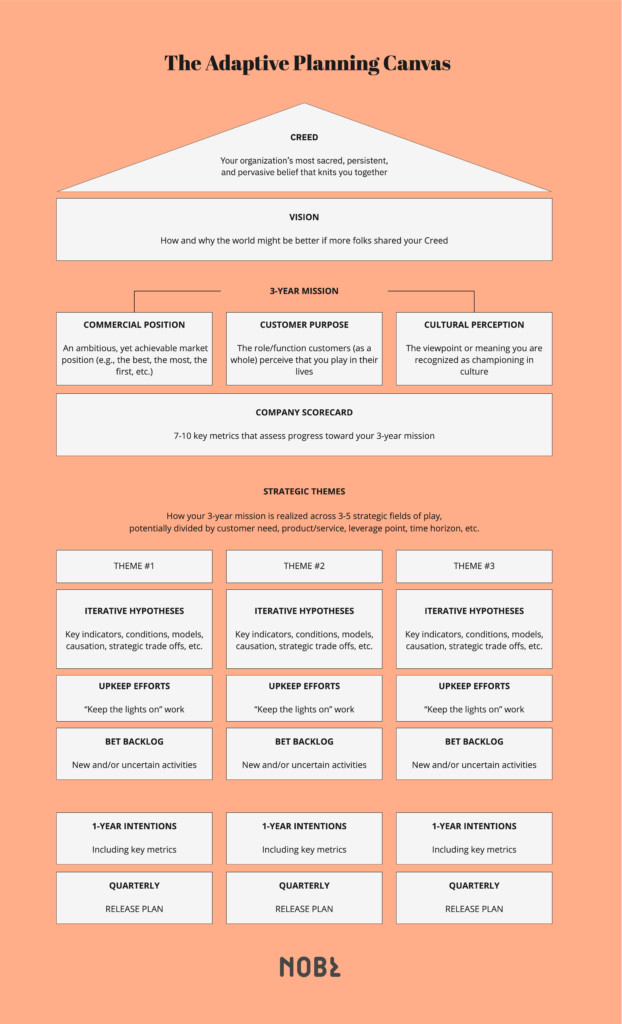There are many adjectives we could use to describe the business landscape of the last decade, some heavily overused—but one word we’d never use is “certain.” As the world has become faster, flatter, and yes, hotter, many have rightly criticized traditional strategic planning as being unresponsive to changing demands, but few alternatives have been suggested.
Starting in 2019, NOBL began leading our clients through our alternative: Adaptive Planning. Our approach borrows heavily from the Agile software development movement (including the scaled agile framework), is inspired by Bayesian reasoning and workflows, and of course, respects many still-relevant lessons from traditional planning.
Adaptive Planning (AP for short) is grounded in a simple premise: you will be wrong. In the short term, you will be a bit wrong. In the long term, without reflection, you will be catastrophically wrong. This isn’t some personal failing, it’s simply the nature of reality today. Titans and visionaries have been wrong, and so will you. AP asks folks to plan as if they’re wrong and it encompasses a series of practices meant to ensure you are less wrong, faster.
A comprehensive introduction to NOBL’s Adaptive Planning
Adaptive Planning is best introduced with its core values and essential practices:
- Core Values. We’ve identified four values that are essential for any team to adopt when long-term planning, such as focusing on outcomes over outputs and learning over comfort. While the exact planning process may vary from team to team, we’ve found that first aligning on these values leads to more consistent results.
- Essential Practices. With client input, we’ve developed twelve practices that spur teams to higher levels of performance and impact, including identifying hypotheses, holding monthly roundtables, and keeping organizational bureaucracy to a minimum. When spread throughout the organization, these practices enable teams to rapidly respond even in the face of ongoing uncertainty.
In addition, we’ve also developed a “canvas” that maps out the work of Adaptive Planning, from the organization’s north star all the way down to quarterly plans. This is what ultimately replaces the five-year plan, and serves as a living, learning representation of the organization.

Key Learnings from Applying Adaptive Planning
Whether you adopt our approach wholesale or not, the most important rules to remember include:
- Orienting towards outcomes, not outputs. It’s easy to track the tasks you do—emails sent, meetings held, features shipped, time spent with the client—which can feel like progress. But more often than not, those aren’t desired outcomes like “market share,” or “increased conversion.” Focusing on the actual impact you want to achieve will help you make smarter decisions about how to get there. Remember, in a complex system like the modern market, the same outcome can be reached by many paths—a concept known as equifinality. Therefore, give your teams both outcomes to reach and room to experiment with ways to get there.
- Creating “bets,” not projects. Calling initiatives “bets” might seem like semantics, but it’s more honest about their predictability and risk—how often have you seen a project with targets that are pulled from thin air or completely divorced from reality? With bets, teams feel greater license to double down or fold, depending on the actual results they see in the market. Of course, it’s also important to distinguish bets from essential operations work. Your organization must do what’s necessary and do it well if it’s going to survive, but be extremely critical about what’s truly mandatory—it’s easy for this category to expand.
- Iterating on your hypotheses. Remember, you’re going to be wrong, but that’s just a point of data, not the end. Return to and revise your assumptions based on actual data. Pro tip: it may take teams a while to truly embrace this approach, as many organizations have historically viewed delays or problems as failure.
- Reviewing and releasing plans every quarter. One of the biggest problems with five-year plans is that they take months to put together… and then are never looked at again. Instead, make a habit of reconvening the planning team every few months to re-align your plans and balance your resources. If the strategic planning team is too big to come together all at once, work together in strategic themes.
- Budgeting incrementally. Just like project goals, budgets are all too often determined by guessing—and the more experimental or long-term a bet is, the less likely that you’ll make an accurate guess. Instead, approach budgeting like a VC with funding gates: commit to a smaller initial spend, and increase spend only if and when the team is able to prove an outcome.
- Hosting regular learning roundtables. Once a quarter, bring teams working on bets together to share what they’ve learned, where they got stuck, and what they accomplished. This is also a good time to get the collective wisdom of the group to triage any bets that are struggling.
What we’ve heard from teams is that while adopting a new rhythm and mindset like Adaptive Planning can feel challenging initially, they soon discover that:
- People in the organization at large love hearing about what is going on—even just reviewing a list of projects makes people feel more in touch with the organization’s progress. Not only that, listing all the projects underway may uncover multiple teams trying to solve the same problem.
- Defining measures and performance targets for outcomes is extremely difficult—but it makes teams truly assess desired outcomes and makes them more accurate, and clients have shared that their people are becoming more strategic.
- Finally, organizations are terrible at killing their darlings. They will do everything in their power to not have to prioritize, because everyone (especially in teams of high-performers) wants to do everything. This approach forces teams to focus their efforts.
Contact us to learn how you can apply Adaptive Planning to your organization.








The Evolutionary Edge
Every Link Ever from Our Newsletter
Why Self-Organizing is So Hard
Welcome to the Era of the Empowered Employee
The Power of “What If?” and “Why Not?”
An Adaptive Approach to the Strategic Planning Process
Why Culture/Market Fit Is More Important than Product/Market Fit
Group Decision Making Model: How to Make Better Decisions as a Team